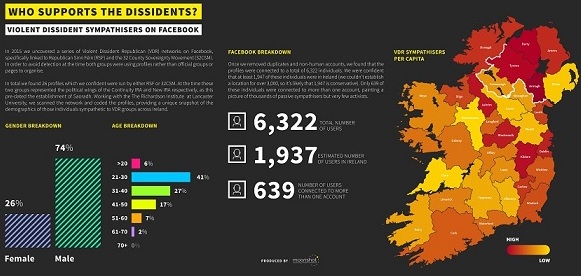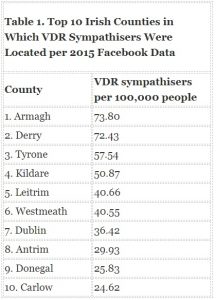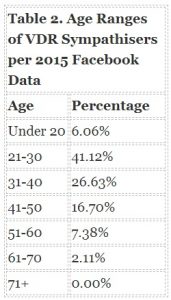By Ross Frenett
Introduction
The murder of Lyra McKee on Good Friday has shone a spotlight on an often under-reported and under-analysed form of violent extremism, violent dissident republicanism (VDR). McKee’s murder was not an aberration; in the past number of years, VDR groups have killed two soldiers, two Police Service of Northern Ireland (PSNI) officers, two prison officers, and have planted dozens of bombs.
In 2015, we uncovered a series of VDR networks on Facebook, specifically linked to Republican Sinn Féin (RSF) and the 32 County Sovereignty Movement (32CSM), two groups that are openly supportive of the Continuity IRA and the New IRA respectively. We are publishing this data today for the first time in the hope that it will prompt additional research, enlighten activists, and encourage better-informed policymaking. The data presented here was gathered before the establishment of Saoradh in 2016 and is somewhat dated, so must be understood as a snapshot of where these groups were at at the time the data was collected, rather than as an up-to-date assessment of contemporary VDR group reach and support.
Data and Methodology
In 2015, the 32CSM and RSF organised themselves on Facebook in a very particular way. Both groups used personal Facebook profiles rather than setting-up official groups or pages. Rather than collecting likes, members or followers in the same way as traditional group profiles or pages, these profiles collected friends. At least in the case of the 32CSM, this was a deliberate strategy,[1] which carried with it a number of advantages for the group. The process of friending a profile associated with a regional branch of the movement requires action on behalf of both parties. This requirement for mutual action makes it far more likely that those connected to these profiles are genuine supporters.
We identified sixteen RSF-controlled profiles and ten 32CSM controlled profiles, with over 20,000 friends between them. Once duplicates and non-human profiles were removed, a final sample of over 6,000 individuals remained. These individual profiles were then coded by a team from the Richardson Peace Institute at Lancaster University on the basis of fourteen factors, including demographics, location, and noteworthy features, such as military training.
Geographic Dispersion
Just over six thousand three hundred VDR sympathisers were identified globally. We established the country of residence for just over half of the sample, with 1,947 sympathisers in Ireland. Eight hundred and twenty-two sympathisers were located in Scotland, 331 in the USA and 253 in England. Small numbers of supporters resided in 66 other countries worldwide, including Japan, Iran, and Venezuela.
Within Ireland, the three counties with the highest concentration of VDR sympathisers per capita were all in Northern Ireland, with Co Armagh and Co Derry standing out as major hotspots. Somewhat more surprising was the concentration of VDR supporters in Kildare (see Table 1).
Gender of Online Sympathisers
29.30% of the sympathisers identified were women and 70.70% were men. This proportion is near-even across RSF and 32CSM. Of those that listed an occupation, women in the dataset were more than three times as likely to identify as unemployed than their male counterparts.
Age of Online Sympathisers
As Horgan and Gill (2011) have highlighted, the average age of those engaged in VDR organisations is considerably higher than those engaged in similar militant organisations in other parts of the world. Our data backs this up (see Table 2).
The weakness of these groups among those under 20 years old is particularly striking. This drop off could be due to a sampling error, though if accurate, VDR groups could face significant trouble in the coming years and decades as they struggle to gain support among the younger generation. This is good news for the foes of these groups and potentially very bad news indeed for the groups themselves.
Offline Activity
Equating online support with offline action is notoriously problematic. A VDR group may be linked to hundreds of people via its Facebook profile, though this does not necessarily imply that this group is able to mobilize hundreds in the offline world. A cumann (i.e. Irish for ‘association’ and a term commonly used in Ireland to refer to local units or branches of political organisations) with a small number of online connections could have a very active offline organisation and a cumann with thousands of connections may have trouble mustering ten people for a protest. In order to better understand the likely offline strength of each cumann, we analysed those connected to each group by location.
Overall, we found that VDR groups have very weak connections with their local population. Only two profiles of 26 analysed showed at least 50% of their support base in their local county. Many profiles that appeared strong on paper drew less than 2% of their supporters from the local community. The most extreme example of this was RSF Tipperary, which boasted over 380 connections, but with only three of those actually hailing from Tipperary itself.
Conclusion
No doubt much has changed since 2015, however, the way in which these groups structured themselves on Facebook at that time allowed for the creation of a vast and rich database on VDR sympathisers. Given recent moves by tech companies to drive VDR groups off their platforms, and the shifts that have taken place in how these groups structure themselves online, it is unlikely that researchers or activists will be able to gain similar insights into the movement as it stands in 2019 using the same methods.
The picture painted here of an ageing movement with thousands of passive sympathisers, few activists, and weak connections to the local community points to a grim future for VDR groups. However, the tradition of armed struggle has renewed and reinvented itself with each generation. Researchers and activists must find new ways to better understand these movements and those that sympathise with them as they evolve.
[1] Interview, 32CSM spokesperson, Dublin, August 2014
Ross Frenett is the Founder of Moonshot CVE, a startup that aims to understand and counter the influence of violent extremists online. Ross has previously carried out fieldwork with VDR groups, including interviewing imprisoned Volunteers in Portlaoise Prison. Ross’ Twitter handle is @rossfrenett and Moonshot’s is @moonshotcve.
This Blog post draws on Moonshot CVE data that was also discussed in the article ‘Dissident Republicans Operate ‘Broad, Unsophisticated Online Networks’ that appeared in yesterday’s Irish Times newspaper.


